A visitor to Paris finds a dark layer of Jewish history in the City of Light
Beyond the city’s wine, food and fashion, the tragic fate of French Jews in World War II is hiding in plain sight
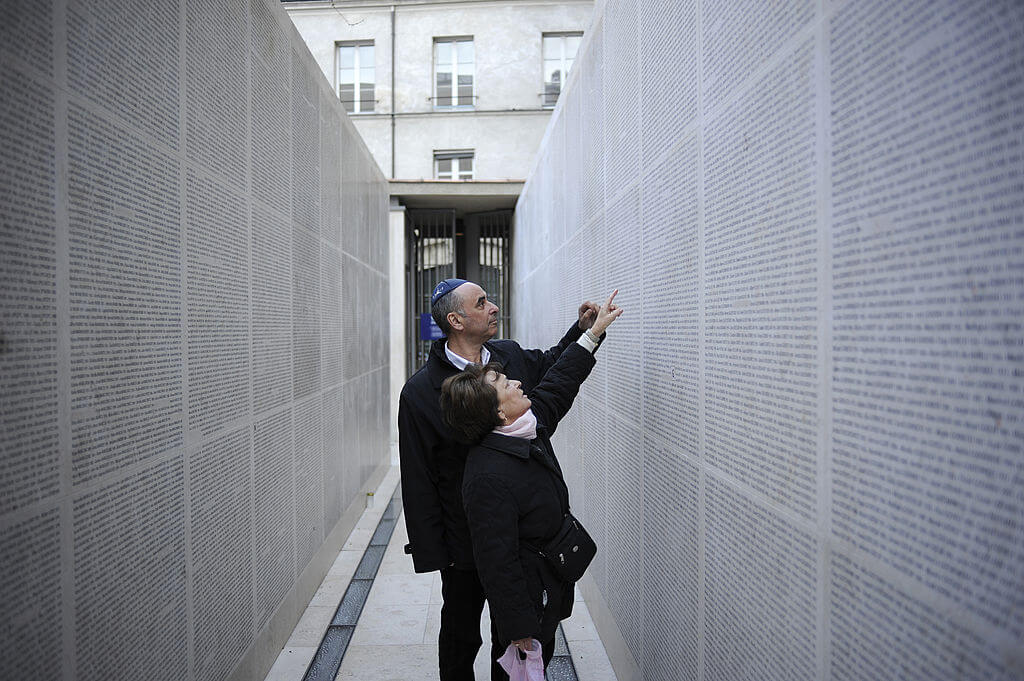
The Wall of Names, listing 76,000 Jews deported from France during World War II, at the Shoah Memorial in Paris. Photo by Fred DuFour/AFP via Getty Images
Think of Paris and you’re likely to think of wine, food, fashion and romance — and maybe even Emily in Paris if you’ve been binging the frothy Netflix hit.
Like so many visitors to the City of Light, I fall in love with Paris every time I go. But on my most recent trip, almost every place I went had a connection to the German occupation of World War II or to the Holocaust. I didn’t plan it that way. But my experience underscored the fact that there’s a Jewish layer, and often one that speaks to tragedy, hiding in plain sight — even in spots that are well-trodden by tourists.
I arrived in Paris after a week spent in Israel communing with other second-generation survivors of the Holocaust like myself. I couldn’t wait to eat, drink, shop and see family and friends in France. I had lived in Paris in the 1970s, covering fashion, nouvelle cuisine and cinema, and I was ready to dive back in.
But from the get-go, things seemed off. When I arrived in mid-November, the city was already festooned in Christmas decorations. When I asked my French cousin about it, she said the Christmas season there starts after the Armistice Day commemoration of the end of World War I. The French don’t have Thanksgiving to delay the start of the Christmas shopping craze.
A family’s fate, obscured
I was staying on the Left Bank near the Eiffel Tower so I could easily make a daily pilgrimage to the gorgeous nearby Bon Marché department store, along with the usual museums. But I started my sightseeing with the Musée Nissim de Camondo, on the Right Bank. It was my only planned dip into the Holocaust.
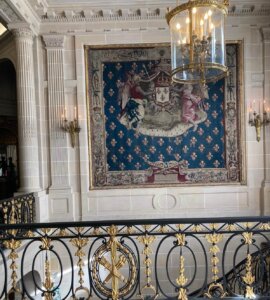
I had learned about the Camondos, a famous Jewish banking family, from the description in Edmund de Waal’s memoir, The Hare with Amber Eyes, which is about de Waal’s own family, the Ephrussis. In the 1800s, the Camondos established themselves in Paris, building huge mansions on the Rue de Monceau.
Both families met dire fates. The Ephrussis were scattered by the war and lost everything. Moise de Camondo, the Camondos’ patriarch, bequeathed his mansion to the French state as a museum named for his son Nissim, who died fighting for France in World War I. Seven years after Moise died in 1935, his daughter Béatrice, her husband and their two children were arrested and deported to Auschwitz. They did not survive.
This mini-Versailles crammed with stunning 18th-century art and antiques collected by the Camondos was enchanting. But nowhere in the tour did I see a reference to the four Camondos who were murdered at Auschwitz.
After drooling over the lavish furniture and Aubusson tapestries, I headed to the Parc Monceau, behind the mansion, with its groomed hedges and children’s carousel. I thought how cruel it was that after they’d given so much to France, the family had been rounded up, along with 75,000 other Jews in France, and sent to their deaths in the camps.
The signs were everywhere
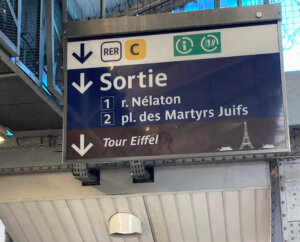
I took the Metro back to the Left Bank and happened to see a sign pointing to the Place des Martyrs Juifs (Square of The Martyred Jews). I had no idea what it was and didn’t pursue it just then. But I see now that the Holocaust had attached itself to me. I was running myself ragged going to art exhibits, shopping and seeing family. But I couldn’t avoid places tainted by the German Occupation and the Holocaust.
The next day, I walked from my hotel past the imposing Hotel des Invalides, a military museum, and took in the gilded Pont Alexandre Trois leading to the Right Bank. Kudos to the French, I thought, for preserving these dramatic vistas.
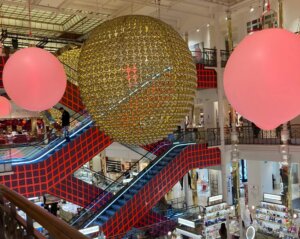
My destination was Le Bon Marché, which means “cheap,” though it no longer is. The store anchors the Sèvres Babylone quartier. Inside, huge red and gold globes hung from high ceilings and the escalators were wrapped in Christmas red. Customers were weighed down with the store’s signature shopping bags.
A notorious hotel
After gaping at gorgeous purses, most priced at $700 or more, I grabbed a table at my favorite cafe, Sip Babylone. I ordered a Caesar salad and a cosmopolitan (shocking to see an American cocktail on the menu!) and stared through the rain-splashed windows at the Hotel Lutetia across the square.
Oh Lord, the Holocaust and World War II were with me again.
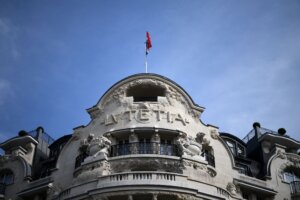
The imposing structure, the only grand hotel on the Left Bank, was built in 1910 with elements of art nouveau and art deco styles. But here’s the dark part: Paris fell to the Nazis on June 14, 1940. The next day, the Abwehr (German military intelligence) requisitioned the building. Here, suspected members of the resistance were interrogated and tortured for four years while German officers lived it up in the hotel, partying on stockpiles of Champagne and French delicacies.
I finished lunch and approached the hotel. It had been sandblasted and restored to its former glory, with cherubs and vines ornamenting its grand façade. A large plaque told of the concentration camp survivors who, after being liberated, wandered dazed into the hotel, which had become a repatriation center. They were still wearing their prison stripes and seeking relatives. The plaque contained no mention of the hotel’s Nazi past.
And this was the pattern. Although former President Jacques Chirac and recently President Emmanuel Macron have apologized for France’s collaboration with the Nazis and the massive deportations, the French in general avoid talk of this period. This was obvious at the Lutetia.
Schiaparelli and ‘Shocking’
On my last day in Paris, I took the Metro to the Musée des Arts Décoratifs to see a massive retrospective on Elsa Schiaparelli, the couturier who was inspired by surrealism. I emerged in the underground shopping mall Le Carrousel du Louvre. Christmas lights and glass ornaments shaped into pendants spelled out “Joyeux Noel.” A stone’s throw away was the famous Jeu de Paume museum where the Nazis stored art and antiques stolen from Jews they’d arrested.
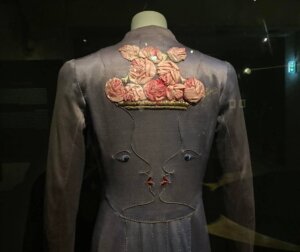
The show, called Shocking: Les Mondes Surréalistes d’Elsa Schiaparelli (“The Surrealist Worlds of Elsa Schiaparelli”), dazzled with sumptuous gowns and jackets that “Schiap” designed from the 1920s to the 1950s. There was a dinner jacket adorned with tiny shot glasses, a red swatch of silk and taffeta with huge ruby-like stones, and much more.
But the backstory was not included. Schiaparelli escaped France in 1940 with her friend and colleague Jean-Michel Frank, a Jewish furniture designer and cousin of Anne Frank. Frank received a lifesaving visa from the Portuguese consul in Bordeaux; Schiaparelli may have gotten one also. Together, they reached Portugal and eventually New York City. In 1941, Frank committed suicide. His designs are now classics, forerunners of contemporary minimalist design.
Don’t get me wrong. I don’t mean to discourage Jews from visiting Paris. My week there was joyous. I loved seeing the dog park in the Tuilerie Gardens (a dog’s life in Paris is enviable). And I trekked to the Fondation Louis Vuitton to see the museum built by Frank Gehry and the stunning exhibit, Monet-Mitchell, pairing Monet’s late Water Lilies with canvases by the American abstract expressionist Joan Mitchell, who lived near Monet’s gardens and was inspired by them. Afterwards, I walked to Le Séquoia Café and gorged on risotto St. Jacques (risotto with scallops in a creamy sauce, oy, treyf) and a glass of cool Sancerre to relax and rejoice.
Place des Martyrs Juifs
Yet the City of Light’s dark side kept surfacing amid its beauty. For example, when I finally looked up the Place des Martyrs Juifs, it turned out to be a small memorial to the 13,000 Parisian Jews rounded up by the French police in 1942. They were herded into the Vélodrome d’Hiver cycling stadium, detained for days without food, water, medical care or sanitary facilities, and then deported to Auschwitz. The French can’t blame this on the Germans. They did it themselves.
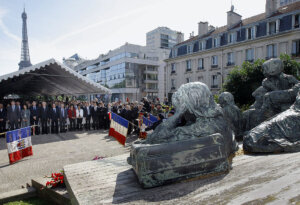
The memorial includes a small sculpture depicting a half-dozen detainees huddling in despair, installed in 1994 on an out-of-the-way promenade along the River Seine. The inscription in French says, “In tribute to the victims of racist persecutions and crimes against humanity.” Could it possibly be more vague?
Perhaps if the French were more upfront about their complicity in the Nazi genocide of the Jews, they could more efficiently confront the ongoing antisemitism embedded in their society. There is a Memorial de la Shoah in Paris, serving as France’s official Holocaust museum and research center. But its Wall of Names only memorializes the Jews in France who were deported to camps in the East. It does not mention the thousands of Jews who were arrested and killed in France.
The short days and gray skies of winter seemed to add a layer of gloom to my experience of these incomplete reminders of past sins. If, like me, you’d be drawn to these sites on your next trip to Paris, perhaps consider going in spring or summer, when the darkness in the City of Light might be easier to bear.



















